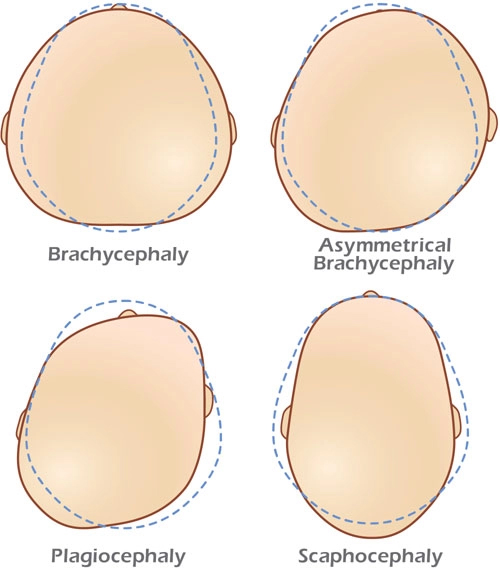Deformational Plagiocephaly
-
The most common type of skull deformity in infants.
-
Normally noticed by caregivers at about six to ten weeks of age.
-
Characterized by an asymmetrical skull shape.
-
Unilateral occipital flattening.
-
Ear is positioned more anterior on the side of the occipital flattening.
-
Forehead may be asymmetrical and is positioned more anterior on the side of the occipital flattening.
-
Facial asymmetry may be present.
-
May be accompanied by torticollis, limited neck range of motion, weakness and preferential head positioning.
Deformational Brachycephaly
-
Central occipital flattening
-
Increased cranial vault height posteriorly. The head is excessively wide for its length.
-
May be accompanied by a prominent, bossed forehead.
Deformational Brachycephaly with Asymmetry
-
Combination of brachycephalic and plagiocephalic characteristics.
-
The shape is disproportionately wide for its length and is also asymmetrical.
-
May or may not include asymmetries to the forehead and facial structure.
Deformational Scaphocephaly
-
Very elongated head shape that is excessively long for its width.
-
May be accompanied by a prominent, bossed forehead.
-
Deformational Scaphocephaly caused by extrinsic forces is uncommon although it is sometimes seen in premature infants who are often positioned side lying, such as NICU infants.
-
Scaphocephaly caused by extrinsic positioning may be confused with sagittal synostosis, a more serious deformity that usually requires surgery to correct.
Learn more about “tummy time” here.

Cranial Remodeling Orthosis
The STARband, Cranial Remolding Orthosis, is part of Orthomerica’s STAR Family of Cranial Remolding Orthoses that provides effective management and treatment of a wide variety of head shape abnormalities. Since 2001, infants have been successfully treated with the STARband throughout the United States and around the globe. The STAR Family of Cranial Remolding Orthoses has been used to treat Deformational Plagiocephaly, Brachycephaly and Scaphocephaly in infants 3-18 months. More recently, Orthomerica has received FDA clearance for the STAR Family of Cranial Remolding Orthoses for post-operative Craniosynostosis.
Why It Works
Cranial remodeling treatment is only effective if you have adequate control over the areas of bossing (bulging) and allow adequate room for growth in the flattened areas. That being said, it is paramount that the holding areas of the helmet match the exact anatomy of your child to prevent skin complications. Treatment with a STARband begins with an initial laser scan of your baby’s head. This enables us to create a custom cranial remolding helmet that is accurate to 0.5mm, ensuring that your child gets the best possible clinical outcome.
Protocol for Treatment
The following guidelines are provided to ensure that the identification of Plagiocephaly and the referral for treatment, are managed to provide optimal results for each patient.
It is recommended that at three months of age, as a standard of practice, each child be evaluated and measured for cranial symmetry. Anthropometric calipers may be used for manual measurement taking.
If it is determined that a cranial asymmetry of 8mm or greater is present, the child needs to be referred to a trained specialist in cranial remolding for treatment, care, and tracking of progress.
How Do We Fix it?
Let Nature Take Her Course – Many cases of abnormal head shape resolve on their own without need of any intervention other than trying to keep your baby from spending too much time in one position. Excessive time spent in a car carrier or being left on their backs in a crib can lead to head shape abnormalities. The best way to compensate for the hours your baby spends on his or her back is to spend some quality “tummy time”.
Tummy Time – Provides parents with ideas and activities to make sure your baby gets enough time on his/her tummy throughout the day, while he/she is awake and supervised. These activities include handling, carrying, diapering, positioning, feeding and playing with your baby. Please visit the Library for more detailed information.
STARband – A baby fortunate enough to be fitted with a STARband in the optimum age range will wear the helmet 23 hours a day and will gently guide the baby’s head into a more normal shape. Please consult with your Physician and/or Orthotist for more detailed information.